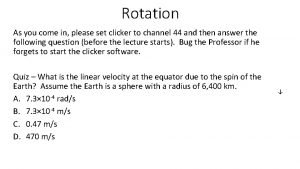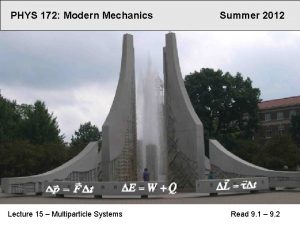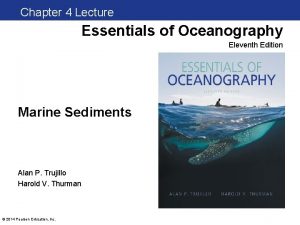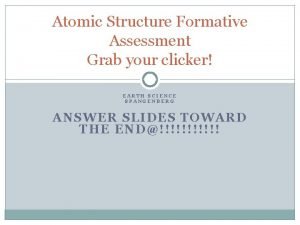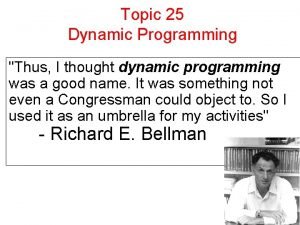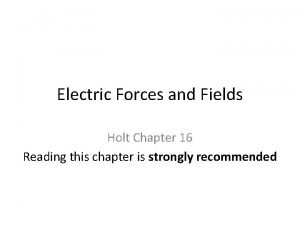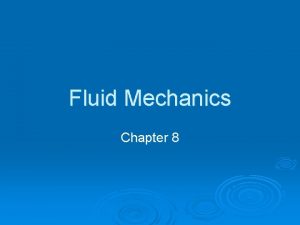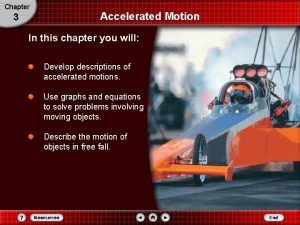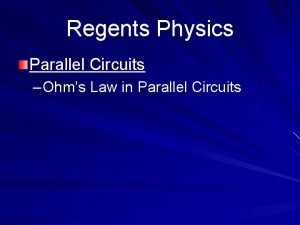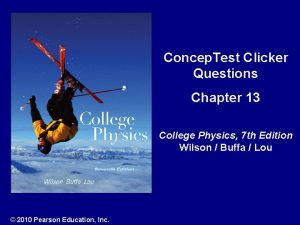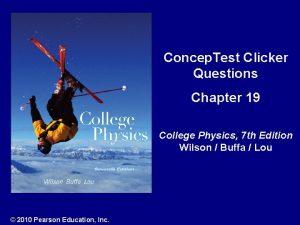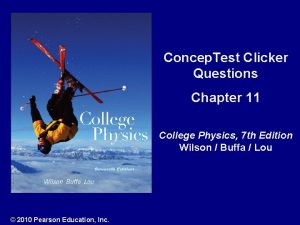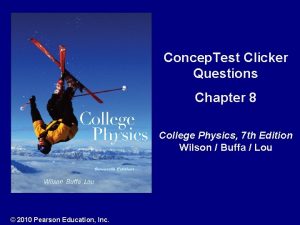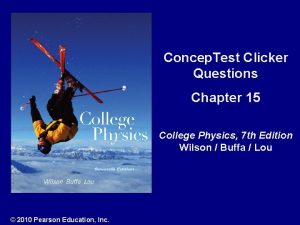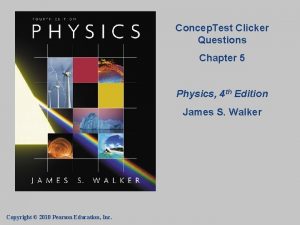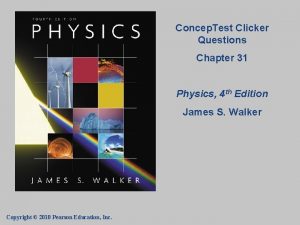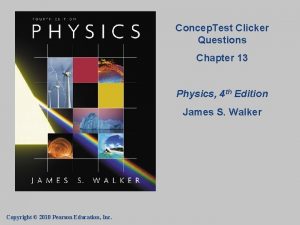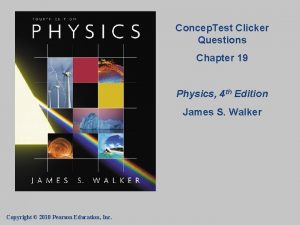Concep Test Clicker Questions Chapter 14 College Physics











































- Slides: 43

Concep. Test Clicker Questions Chapter 14 College Physics, 7 th Edition Wilson / Buffa / Lou © 2010 Pearson Education, Inc.

Question 14. 1 a Sound Bite I When a sound wave passes from air into water, what properties of the wave will change? a) the frequency f b) the wavelength l c) the speed of the wave d) both f and l e) both vwave and l

Question 14. 1 a Sound Bite I When a sound wave passes from air into water, what properties of the wave will change? a) the frequency f b) the wavelength l c) the speed of the wave d) both f and l e) both vwave and l Wave speed must change (different medium). Frequency does not change (determined by the source). Now, v = fl and because v has changed and f is constant then l must also change Follow-up: Does the wave speed increase or decrease in water?

Question 14. 1 b Sound Bite II We just determined that the wavelength of the sound wave will change when it passes from air into water. How will the wavelength change? a) wavelength will increase b) wavelength will not change c) wavelength will decrease

Question 14. 1 b Sound Bite II We just determined that the wavelength of the sound wave will change when it passes from air into water. How will the wavelength change? a) wavelength will increase b) wavelength will not change c) wavelength will decrease The speed of sound is greater in water, because the force holding the molecules together is greater. This is generally true for liquids, as compared to gases. If the speed is greater and the frequency has not changed (determined by the source), then the wavelength must also have increased (v = fl).

Question 14. 2 a Speed of Sound I a) water Do sound waves travel faster in water or in ice? b) ice c) same speed in both d) sound can only travel in a gas

Question 14. 2 a Speed of Sound I a) water Do sound waves travel faster in water or in ice? b) ice c) same speed in both d) sound can only travel in a gas Speed of sound depends on the inertia of the medium and the restoring force Because ice and water both consist of water molecules, the inertia is the same for both. However, the force holding the molecules together is greater in ice (because it is a solid), so the restoring force is greater. Because v = , the speed of sound must be greater in ice! ice

Question 14. 2 b Speed of Sound II Do you expect an echo to return to you more quickly or less quickly on a hot day, as compared to a cold day? a) more quickly on a hot day b) equal times on both days c) more quickly on a cold day

Question 14. 2 b Speed of Sound II Do you expect an echo to return to you more quickly or less quickly on a hot day, as compared to a cold day? a) more quickly on a hot day b) equal times on both days c) more quickly on a cold day The speed of sound in a gas increases with temperature. This is because the molecules are bumping into each other faster and more often, so it is easier to propagate the compression wave (sound wave).

Question 14. 2 c Speed of Sound III If you fill your lungs with helium and then try talking, you sound like Donald Duck. What conclusion can you reach about the speed of sound in helium? a) speed of sound is less in helium b) speed of sound is the same in helium c) speed of sound is greater in helium d) this effect has nothing to do with the speed in helium

Question 14. 2 c Speed of Sound III If you fill your lungs with helium and then try talking, you sound like Donald Duck. What conclusion can you reach about the speed of sound in helium? a) speed of sound is less in helium b) speed of sound is the same in helium c) speed of sound is greater in helium d) this effect has nothing to do with the speed in helium The higher pitch implies a higher frequency. In turn, because v = fl, this means that the speed of the wave has increased (as long as the wavelength, determined by the length of the vocal chords, remains constant). Follow-up: Why is the speed of sound greater in helium than in air?

Question 14. 3 Wishing Well You drop a rock into a well, and you hear the splash 1. 5 s later. If the depth of the well were doubled, how long after you drop the rock would you hear the splash in this case? a) more than 3 s later b) 3 s later c) between 1. 5 s and 3 s later d) 1. 5 s later e) less than 1. 5 s later

Question 14. 3 Wishing Well You drop a rock into a well, and you hear the splash 1. 5 s later. If the depth of the well were doubled, how long after you drop the rock would you hear the splash in this case? a) more than 3 s later b) 3 s later c) between 1. 5 s and 3 s later d) 1. 5 s later e) less than 1. 5 s later Because the speed of sound is so much faster than the speed of the falling rock, we can essentially ignore the travel time of the sound. As for the falling rock, it is accelerating as it falls, so it covers the bottom half of the deeper well much quicker than the top half. The total time will not be exactly 3 s, but somewhat less. Follow-up: How long does the sound take to travel the depth of the well?

Question 14. 4 a Sound Intensity I You stand a certain distance away from a speaker and you hear a certain intensity of sound. If you double your distance from the speaker, what happens to the sound intensity at your new position? a) drops to ½ its original value b) drops to ¼ its original value c) drops to 1/8 its original value d) drops to 1/16 its original value e) does not change at all

Question 14. 4 a Sound Intensity I You stand a certain distance away from a speaker and you hear a certain intensity of sound. If you double your distance from the speaker, what happens to the sound intensity at your new position? a) drops to ½ its original value b) drops to ¼ its original value c) drops to 1/8 its original value d) drops to 1/16 its original value e) does not change at all For a source of a given power P, the intensity is given by I = P/4 pr 2. So if the distance doubles, doubles the intensity must decrease to one-quarter its original value. Follow-up: What distance would reduce the intensity by a factor of 100?

Question 14. 4 b Sound Intensity II You hear a fire truck with a certain intensity, and you are about 1 mile away. Another person hears the same fire truck with an intensity that is about 10 times less. Roughly, how far is the other person from the fire truck? a) about the same distance b) about 3 miles c) about 10 miles d) about 30 miles e) about 100 miles

Question 14. 4 b Sound Intensity II You hear a fire truck with a certain intensity, and you are about 1 mile away. Another person hears the same fire truck with an intensity that is about 10 times less. Roughly, how far is the other person from the fire truck? Remember that intensity drops with the inverse square of the distance, distance so if intensity drops by a factor of 10, the other person must be 10 farther away, which is about a factor of 3. a) about the same distance b) about 3 miles c) about 10 miles d) about 30 miles e) about 100 miles

Question 14. 5 a Decibel Level I When Mary talks, she creates an intensity level of 60 d. B at your location. Alice talks with the same volume, also giving 60 d. B at your location. If both Mary and Alice talk simultaneously from the same spot, what would be the new intensity level that you hear? a) more than 120 d. B b) 120 d. B c) between 60 d. B and 120 d. B d) 60 d. B e) less than 60 d. B

Question 14. 5 a Decibel Level I When Mary talks, she creates an intensity level of 60 d. B at your location. Alice talks with the same volume, also giving 60 d. B at your location. If both Mary and Alice talk simultaneously from the same spot, what would be the new intensity level that you hear? a) more than 120 d. B b) 120 d. B c) between 60 d. B and 120 d. B d) 60 d. B e) less than 60 d. B Recall that a difference of 10 d. B in intensity level b corresponds to a factor of 101 in intensity. Similarly, a difference of 60 d. B in b corresponds to a factor of 106 in intensity!! In this case, with two voices adding up, the intensity increases by only a factor of 2, meaning that the intensity level is higher by an amount equal to Db = 10 log(2) = 3 d. B. The new intensity level is b = 63 d. B.

Question 14. 5 b Decibel Level II A quiet radio has an intensity level of about 40 d. B. Busy street traffic has a level of about 70 d. B. How much greater is the intensity of the street traffic compared to the radio? a) about the same b) about 10 times c) about 100 times d) about 1000 times e) about 10, 000 times

Question 14. 5 b Decibel Level II A quiet radio has an intensity level of about 40 d. B. Busy street traffic has a level of about 70 d. B. How much greater is the intensity of the street traffic compared to the radio? a) about the same b) about 10 times c) about 100 times d) about 1000 times e) about 10, 000 times increase by 10 d. B increase intensity by factor of 101 (10) increase by 20 d. B increase intensity by factor of 102 (100) increase by 30 d. B increase intensity by factor of 103 (1000) Follow-up: What decibel level gives an intensity a million times greater?

Question 14. 5 c Decibel Level III Intensity level is given by b = 10 log(I/I 0) with I 0 = 10− 12 W/m 2. The usual threshold of human hearing is defined as intensity level of b = 0 d. B. What does this actually mean in terms of sound intensity? a) intensity is undefined at that level b) intensity is 100 W/m 2 c) intensity is 0. 0 W/m 2 d) intensity is 10− 12 W/m 2 e) intensity is 1. 0 W/m 2

Question 14. 5 c Decibel Level III Intensity level is given by b = 10 log(I/I 0) with I 0 = 10− 12 W/m 2. The usual threshold of human hearing is defined as intensity level of b = 0 d. B. What does this actually mean in terms of sound intensity? a) intensity is undefined at that level b) intensity is 100 W/m 2 c) intensity is 0. 0 W/m 2 d) intensity is 10− 12 W/m 2 e) intensity is 1. 0 W/m 2 In order for b to be equal to zero, the term log(I/I 0) must also be zero. This occurs when the argument is 1. 0, because log(1. 0) = 0. In other words, the value of I must be equal to I 0.

Question 14. 6 a Pied Piper I You have a long pipe a) the long pipe and a short pipe. b) the short pipe Which one has the c) both have the same frequency higher frequency? d) depends on the speed of sound in the pipe

Question 14. 6 a Pied Piper I You have a long pipe a) the long pipe and a short pipe. b) the short pipe Which one has the c) both have the same frequency higher frequency? d) depends on the speed of sound in the pipe A shorter pipe means that the standing wave in the pipe would have a shorter wavelength Because the wave speed remains the same, the frequency has to be higher in the short pipe.

Question 14. 6 b Pied Piper II A wood whistle has a variable length. You just heard the tone from the whistle at maximum length. If the air column is made shorter by moving the end stop, what happens to the frequency? a) frequency will increase b) frequency will not change c) frequency will decrease

Question 14. 6 b Pied Piper II A wood whistle has a variable length. You just heard the tone from the whistle at maximum length. If the air column is made shorter by moving the end stop, what happens to the frequency? a) frequency will increase b) frequency will not change c) frequency will decrease A shorter pipe means that the standing wave in the pipe would have a shorter wavelength Because the wave speed remains the same, and we know that v = f l, then we see that the frequency has to increase when the pipe is made shorter.

Question 14. 6 c Pied Piper III If you blow across the opening of a partially filled soda bottle, you hear a tone. If you take a big sip of soda and then blow across the opening again, how will the frequency of the tone change? a) frequency will increase b) frequency will not change c) frequency will decrease

Question 14. 6 c Pied Piper III If you blow across the opening of a partially filled soda bottle, you hear a tone. If you take a big sip of soda and then blow across the opening again, how will the frequency of the tone change? a) frequency will increase b) frequency will not change c) frequency will decrease By drinking some of the soda, you have effectively increased the length of the air column in the bottle. A longer pipe means that the standing wave in the bottle would have a longer wavelength Because the wave speed remains the same, and we know that v = f l, then we see that the frequency has to be lower Follow-up: Why doesn’t the wave speed change?

Question 14. 7 Open and Closed Pipes You blow into an open pipe and produce a tone. What happens to the frequency of the tone if you close the end of the pipe and blow into it again? a) depends on the speed of sound in the pipe b) you hear the same frequency c) you hear a higher frequency d) you hear a lower frequency

Question 14. 7 Open and Closed Pipes You blow into an open pipe and produce a tone. What happens to the frequency of the tone if you close the end of the pipe and blow into it again? a) depends on the speed of sound in the pipe b) you hear the same frequency c) you hear a higher frequency d) you hear a lower frequency In the open pipe, pipe of a wave “fits” into the pipe, and in the closed pipe, pipe only of a wave fits. Because the wavelength is larger in the closed pipe, pipe the frequency will be lower Follow-up: What would you have to do to the pipe to increase the frequency?

Question 14. 8 Out of Tune When you tune a guitar string, what physical characteristic of the string are you actually changing? a) the tension in the string b) the mass per unit length of the string c) the composition of the string d) the overall length of the string e) the inertia of the string

Question 14. 8 Out of Tune When you tune a guitar string, what physical characteristic of the string are you actually changing? a) the tension in the string b) the mass per unit length of the string c) the composition of the string d) the overall length of the string e) the inertia of the string By tightening (or loosening) the knobs on the neck of the guitar, you are changing the tension in the string. This alters the wave speed and therefore alters the frequency of the fundamental standing wave because f = v/2 L. Follow-up: To increase frequency, do you tighten or loosen the strings?

Question 14. 9 Interference Speakers A and B emit sound waves of l = 1 m, which interfere constructively at a donkey located far away (say, 200 m). What happens to the sound intensity if speaker A steps back 2. 5 m? A B a) intensity increases b) intensity stays the same c) intensity goes to zero d) impossible to tell L

Question 14. 9 Interference Speakers A and B emit sound waves of l = 1 m, which interfere constructively at a donkey located far away (say, 200 m). What happens to the sound intensity if speaker A steps back 2. 5 m? a) intensity increases b) intensity stays the same c) intensity goes to zero d) impossible to tell If l = 1 m, m then a shift of 2. 5 m corresponds to 2. 5 l, which puts the two waves out of phase, phase leading to destructive interference The sound intensity will therefore go to zero. Follow-up: What if you move back by 4 m? A B L

Question 14. 10 Beats The traces below show beats that occur when two different pairs of waves interfere. For which case is the difference in frequency of the original waves greater? Pair 1 a) pair 1 b) pair 2 c) same for both pairs d) impossible to tell by just looking Pair 2

Question 14. 10 Beats The traces below show beats that occur when two different pairs of waves interfere. For which case is the difference in frequency of the original waves greater? a) pair 1 b) pair 2 c) same for both pairs d) impossible to tell by just looking Recall that the beat frequency is the difference in frequency between the two waves: fbeat = f 2 – f 1. Pair 1 has the greater beat frequency (more oscillations in same time period), so pair 1 has the greater frequency difference Pair 1 Pair 2

Question 14. 11 a Doppler Effect I Observers A, B, and C listen to a moving source of sound. The location of the wave fronts of the moving source with respect to the observers is shown below. Which of the following is true? a) frequency is highest at A b) frequency is highest at B c) frequency is highest at C d) frequency is the same at all three points

Question 14. 11 a Doppler Effect I Observers A, B, and C listen to a moving source of sound. The location of the wave fronts of the moving source with respect to the observers is shown below. Which of the following is true? a) frequency is highest at A b) frequency is highest at B c) frequency is highest at C d) frequency is the same at all three points The number of wave fronts hitting observer C per unit time is greatest—thus the observed frequency is highest there. Follow-up: Where is the frequency lowest?

Question 14. 11 b Doppler Effect II You are heading toward an island in a speedboat and you see your friend standing on the shore, at the base of a cliff. You sound the boat’s horn to alert your friend of your arrival. If the horn has a rest frequency of f 0, what frequency does your friend hear ? a) lower than f 0 b) equal to f 0 c) higher than f 0

Question 14. 11 b Doppler Effect II You are heading toward an island in a speedboat and you see your friend standing on the shore, at the base of a cliff. You sound the boat’s horn to alert your friend of your arrival. If the horn has a rest frequency of f 0, what frequency does your friend hear ? a) lower than f 0 b) equal to f 0 c) higher than f 0 Due to the approach of the source toward the stationary observer, the frequency is shifted higher This is the same situation as depicted in the previous question.

Question 14. 11 c Doppler Effect III In the previous question, the horn had a rest frequency of f 0, and we found that your friend heard a higher frequency f 1 due to the Doppler shift. The sound from the boat hits the cliff behind your friend and returns to you as an echo. What is the frequency of the echo that you hear? a) lower than f 0 b) equal to f 0 c) higher than f 0 but lower than f 1 d) equal to f 1 e) higher than f 1

Question 14. 11 c Doppler Effect III In the previous question, the horn had a rest frequency of f 0, and we found that your friend heard a higher frequency f 1 due to the Doppler shift. The sound from the boat hits the cliff behind your friend and returns to you as an echo. What is the frequency of the echo that you hear? a) lower than f 0 b) equal to f 0 c) higher than f 0 but lower than f 1 d) equal to f 1 e) higher than f 1 The sound wave bouncing off the cliff has the same frequency f 1 as the one hitting the cliff (what your friend hears). For the echo, you are now a moving observer approaching the sound wave of frequency f 1 so you will hear an even higher frequency
 Clicker questions physics
Clicker questions physics Gamit ang web mapping magbigay ng mga alam mong kultura
Gamit ang web mapping magbigay ng mga alam mong kultura Math clicker
Math clicker E clicker
E clicker Turning point audience response system
Turning point audience response system Lesson 5 building an app clicker game
Lesson 5 building an app clicker game Earth clicker
Earth clicker Heart rate clicker
Heart rate clicker Hitler clicker
Hitler clicker Clicker stop motion
Clicker stop motion Cooi clicker
Cooi clicker Umbc clicker
Umbc clicker Clicker box
Clicker box Youtube youtube
Youtube youtube Clicker stop motion
Clicker stop motion Clicker
Clicker Phys 172
Phys 172 Buzka clicker
Buzka clicker Salt clicker
Salt clicker Clicker gravel transport
Clicker gravel transport Atomic clicker
Atomic clicker Spacebar clicker
Spacebar clicker Fibonacci clicker
Fibonacci clicker Clicker
Clicker Presentation clicker challenger
Presentation clicker challenger Cosine rule bbc
Cosine rule bbc A physical change occurs when a peach spoils
A physical change occurs when a peach spoils Clicker fungus
Clicker fungus Direction of dipole moment
Direction of dipole moment Chapter 12 physics test
Chapter 12 physics test Chapter 8 fluid mechanics
Chapter 8 fluid mechanics Chapter 2 assessment physics
Chapter 2 assessment physics Chapter 3 accelerated motion practice problems answers
Chapter 3 accelerated motion practice problems answers Modern physics vs classical physics
Modern physics vs classical physics University physics with modern physics fifteenth edition
University physics with modern physics fifteenth edition Physics ia format
Physics ia format College physics: explore and apply solutions
College physics: explore and apply solutions Excelsior college basic genetics
Excelsior college basic genetics Asd college college readiness program
Asd college college readiness program Early college high school at midland college
Early college high school at midland college Regents physics circuits
Regents physics circuits Sankey diagram for one bounce of a ball answers
Sankey diagram for one bounce of a ball answers Formula for weight physics
Formula for weight physics Distance time graph for uniform motion
Distance time graph for uniform motion











